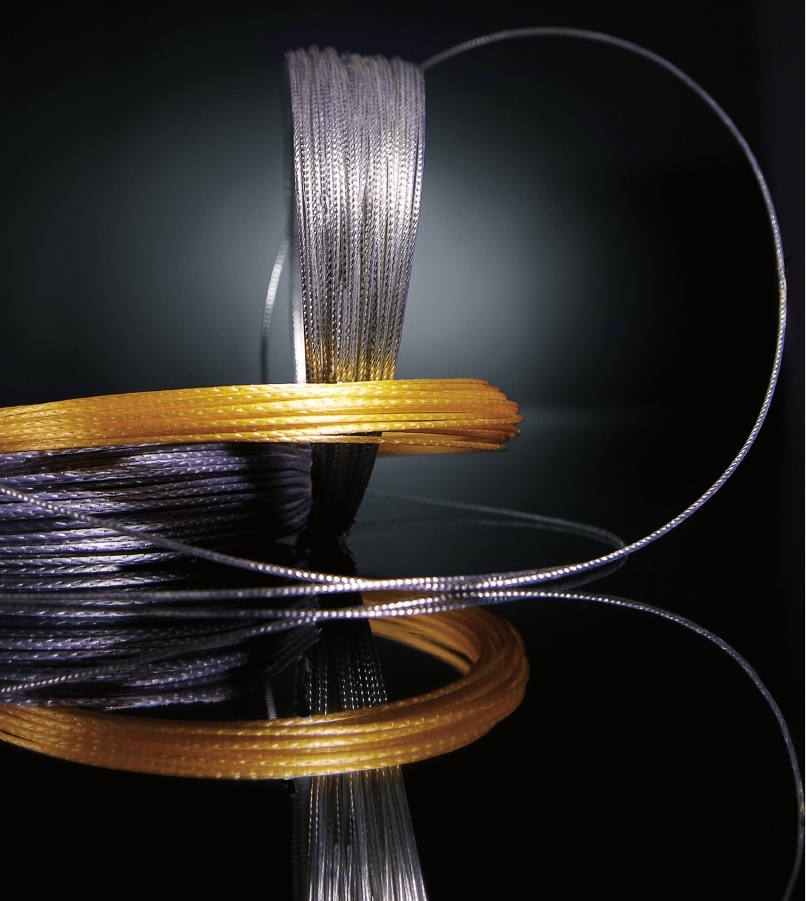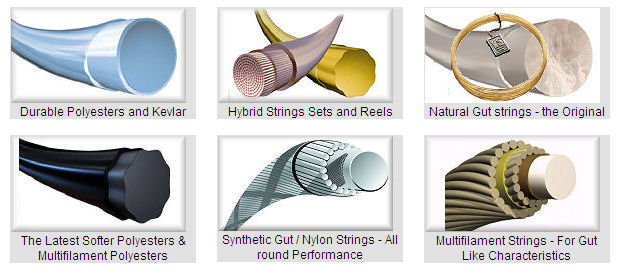STRINGS & TENSIONS

The
strings are the most over looked part of the racket and yet they are (or at least should be) the only part of the racket to make contact with the ball. There is a very big selection of strings available so it is important to understand that not all strings suit all players.
It is very important to know how strings perform and then you can choose from here. A qualified stringer will help you with this.
The most important part of restringing is consistency. You should try to use the same machine and preferably the same stringer each time. This will ensure your racket feels and plays the same every time.
Generally, unless you buy an unstrung racket and specify the string type and
tension, most rackets will be strung midway in the
recommended range.
The recommended range is the range at
which the suppliers think the racket will perform at its best.
Each recommended range usually offers a 10lb margin eg. 50-60lbs. The range is printed on the frame and should be reduced by 10% when stringing with polyester strings.
Regular stringing ensures your racket performs at its optimum for longer.
The
higher the tension the greater the control, the lower the tension the greater
the power.
Different string types offer different levels of power or control. Below are the different string materials available and also the types of player they suit. String thickness also has a strong bearing on how your racket will perform.
String Types:
- Synthetic Gut: This covers both nylon and synthetic gut. Synthetic gut is made up of high quality nylon. A lot people still use this type of string as it offers a good level of durability, as well as playability. Even in hybrids, which will be explained later, nylon can be used as one the strings.
- Textured: This is a string with a roughness to it. It provides more spin to those who naturally play with spin. It will not provide spin to flat hitters. The textured surface grips the ball more and therefore adds to the spin.
- Polyester (Co-poly): This is the fashionable string of the moment and a lot of people ask for this string without really knowing what it is supposed to do. It is a more durable string so for the person that is regularly breaking strings it is one worth considering but know what it does before changing to it. It doesn't move and deadens the string bed. This allows the hard hitters, fast swingers, to really be aggressive and still have good control. Polyester strings offer little power or feel, so expect balls to land short of the baseline unless you increase your swing speed to compensate. Polyester string is not recommended for beginners, juniors or those suffering from tennis elbow. Another thing worth noting about polyester string is that it looses its' tension quicker than other strings.
- Polyamides: These strings are getting more attention as an alternative to polyester, as they are less harsh on the arm. The platers been targeted most with these strings are juniors who are been moved onto polyester too soon. They provide a very high level of control, similar to polyester, but have greater elongation and therefore are less severe on the arm and also provide more power. Generally they are made up of polyester and nylon fibres, although some strings in this category feature no poly at all.
- Hybrids: This is where players combine polyester with a softer string, either synthetic gut, or for the professional feel, natural gut or multifilament. This offers the durability benefits of polyester and reduces the stiff, dead feel from the string bed. Again, not recommended for beginners or players with, or prone to tennis elbow. The string you use in the mains will dictate the playability of racket.
- Multifilament: Multifilament is the closest string type to the very expensive Natural Gut. It is a very soft string that offers lots of power and comfort. A very good string for those who suffer from tennis elbow. This string shreds as it gets worn and to club players this is perceived as poor quality string, where in fact it is probably the nicest string to play with.
How to choose your tension:
As I said earlier "the higher the tension the greater the control, the lower the tension the greater the power".
- Control - tighter strings, means less deflection and because of this the ball deforms more, providing less energy return than looser strings. These strings also enable you to create greater spin, provided you play with spin already.
- Power - When you lower the tension the stringbed will deflect more and therefore the ball less, returning greater energy to the ball therefore giving more power. One of the benefits of stringing the racket at lower tension is less chance of tennis elbow. This is because lower tensions provide a softer feel and larger sweetspot, reducing the amount of shock and vibration to the arm. The down side to lower tension is that your strings will move around more.
String Thickness:
Tennis strings come in a range of thicknesses, also known as gauge, but most commonly 15 - 19. 15 being the thickest and 19 being the thinnest. The general consensus is that thicker strings offer more control and thinner strings offer more power and spin. It is also worth noting that thinner strings break more frequently.
String Gauges and Diameters in millimeters
| 15 | = | 1.41-1.49 mm | 17 | = | 1.20-1.24 mm |
| 15L | = | 1.34-1.40 mm | 17L | = | 1.16-1.20 mm |
| 16 | = | 1.26-1.33 mm | 18 | = | 1.10-1.16 mm |
| 16L | = | 1.22-1.26 mm | 19 | = | 1.00-1.10 mm |


